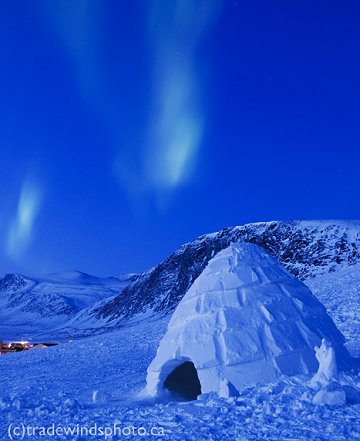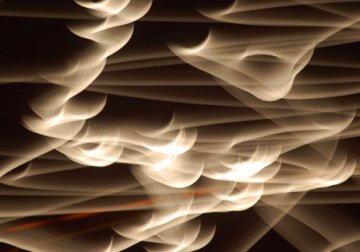| Where's Saturn? Is that a UFO--or the ISS? What's the name of that star? Get the answers from mySKY--a fun new astronomy helper from Meade. | |  | SOYUZ AND MIZAR: A new crew for the International Space Station blasted off from the Baikonur Cosmodrome in Kazakhstan on Tuesday morning, April 8th. Hours later, Kevin Fetter photographed their Soyuz spacecraft passing by the star Mizar en route to the ISS: video. "It was a nice bright flyby," he says. "I'm glad I got to see it." The Soyuz is due to reach the ISS and dock to the busy station on Thursday, April 10th. AURORA WATCH: "Last night, I was out trying to photograph an igloo in the evening twilight, when all of a sudden an explosion of light danced overhead," reports Claus Vogel on Baffin Island, Canada. "I have never seen the aurora so bright at dusk - and what timing. I had my Nikon D300 and tripod ready when the lights began their northern dance." 
"I have always dreamed of this. Woweee!!" Similar displays are in the offing tonight. A solar wind stream is buffeting Earth's magnetic field and causing intermittent geomagnetic storms. Northern sky watchers, be alert for auroras. SIDNEY'S CONJUNCTION: Last night's conjunction of the crescent Moon and the Pleiades was tail-wagging beautiful. Literally. "My friend's dog, Sidney, decided that wagging her tail against my tripod was a great idea," says photographer Greg Scheckler of North Adams, Massachusetts. Here is the result: 
"Happy accident or strange goof," he says, "we now have an abstract picture of Luna with the Seven (or three hundred!) Sisters." Click on these links to view more traditional exposures: from Sanath Kumar of South Dakota State University, Brookings, SD; from Gary J. Cooper of New York City, NY; from Robert B Slobins of Karluv Most (Charles Bridge), Prague, Czech Republic; from Tom Cocchiaro at Pease International Airport, Portsmouth, New Hampshire; from Patrick Boomer of West of Red Deer, Alberta, Canada; from Alan Dyer of Cluny, Alberta; from Jeffrey Berkes of West Chester, PA; from Mark Riddick of Staunton, Virginia; from David Harvey of Tucson, Arizona; from Dr. Fritz Helmut Hemmerich of Tenerife, Canary Islands, Spain; from Pete Lawrence of Selsey, West Sussex, UK; from P. Presby, J. Fairfull and J. Stetson of South Portland, Maine; from Tim Printy of Manchester, NH; from Jan Koeman of Kloetinge, The Netherlands; from Piotr Majewski of Torun, Poland; from Alex Lloyd-Ribeiro of Manchester, England; from Geir Øye of Ørsta, Norway; from Dean Drumheller of San Mateo CA; from Mohammad Smadi of Fargo, North Dakota; from Phil Harrington of Oakdale, NY;
March 2008 Aurora Gallery
[Aurora Alerts] [Night-sky Cameras] | 
